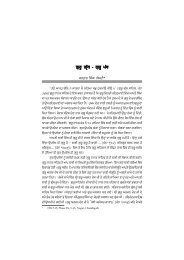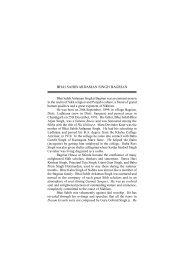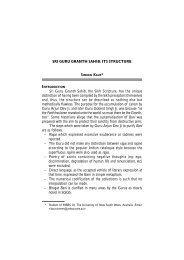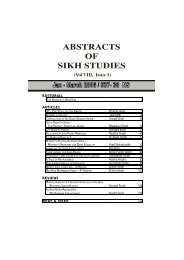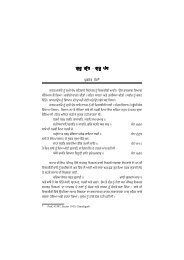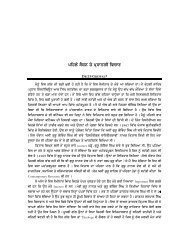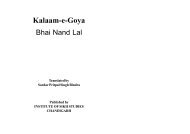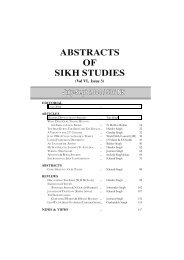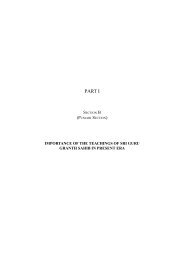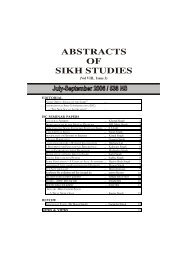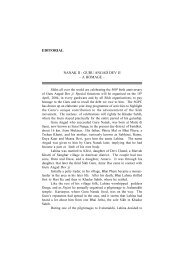editorial articles reviews news & views - Institute of Sikh Studies
editorial articles reviews news & views - Institute of Sikh Studies
editorial articles reviews news & views - Institute of Sikh Studies
Create successful ePaper yourself
Turn your PDF publications into a flip-book with our unique Google optimized e-Paper software.
50<br />
ABSTRACTS OF SIKH STUDIES : APRIL-JUNE 2005 / 537 NS<br />
among Hindus, and there was hardly any social intermixing among<br />
them. Muslims were absolutely a humanity apart. At that time Guru<br />
Nanak appeared on the scene and galvanized Indian citizenry by the<br />
slogan <strong>of</strong> ‘Oneness <strong>of</strong> God and Brotherhood <strong>of</strong> all mankind’. By<br />
associating with Bhai Mardana, a Muslim <strong>of</strong> the same village as his<br />
life long friend, he broke the religious barriers and traveled 39,000<br />
miles throughout the world including Mecca, Jagannathpuri and<br />
Haridwar. He stayed with Bhai Lalo rather than Malik Bhago breaking<br />
the high/low barrier. The institution <strong>of</strong> Sangat and Pangat was a<br />
revolution in Indian social intermixing.<br />
Now I come to Guru Arjun Dev. The foundation <strong>of</strong> Golden<br />
Temple, the most revered <strong>Sikh</strong> shrine, was laid by a Muslim Faqir Sain<br />
Mian Mir in December 1588.<br />
The compilation <strong>of</strong> Guru Granth Sahib by Guru Arjun Dev and<br />
its installation in Harmandir Sahib on 1 st September, 1604, deserves<br />
special deliberation. This eternal Guru <strong>of</strong> the <strong>Sikh</strong>s - nay the entire<br />
humanity, has some striking features.<br />
The Granth contains, besides the writings <strong>of</strong> the <strong>Sikh</strong> Gurus,<br />
compositions <strong>of</strong> almost all the medieval Hindu Bhaktas, like Kabir,<br />
Ramanand, Ravidas, Surdas, Sain, Bhikhan from UP; Jaidev from<br />
Bengal; Namdev, Trilochan and Parmanand from Maharashtra; Pipa<br />
and Dhanna from Rajasthan; and Beni, then popular all over North<br />
India. The writings <strong>of</strong> four Muslims — Baba Farid, Bhikhan, Satta,<br />
Balwand are also incorporated in the Granth. Here is then national<br />
integration at its best.<br />
By far, the largest portion <strong>of</strong> the Granth is composed in a mixed<br />
language, a mixture <strong>of</strong> western Hindi, Prakrit, Braj, Punjabi and the<br />
then current vocabulary <strong>of</strong> Persian and Arabic. So, not only in subjectmatter,<br />
or religious affiliations <strong>of</strong> its authors, but also in language the<br />
Granth upholds the creed <strong>of</strong> integration as against exclusiveness.<br />
Oneness <strong>of</strong> God was Guru Nanak’s cardinal principle :<br />
God first created Light; all beings belong to nature.<br />
Since from one Light is the whole world created – who is noble,<br />
who inferior 1<br />
THE ABOLITION OF CONCEPT OF HIGH AND LOW<br />
The contribution to Guru Granth Sahib came mainly from the



